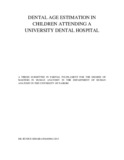| dc.description.abstract | Background: There are various circumstances when the chronological age of a child
needs to be verified but due to lack of legally approved documentary evidence, age has to
be conventionally estimated. Determination of age provides an important biological data
which plays a vital role in the identification of victims of mass disasters and crimes.
Additionally, it is an important requirement during school admission, marriage, childadoption,
in determination of criminal responsibility, imprisonment of minors and in
management of various orthodontic as well as pediatric conditions and pathologies.
Various methods have been applied to estimate the age of children mainly through the
assessment of developmental and morphological changes of bone and teeth. However, in
Kenya there is hardly any approved method that can be used to achieve this purpose.
Hence, the need to determine the applicability of the available methods in estimating the
age of a given Kenyan population.
Objective: To determine the performance of Willems‘ model of age estimation in
children visiting the University of Nairobi Dental Hospital.
Materials and method: A cross sectional study was done at The University of Nairobi
Dental Hospital. It involved examination of panoramic radiographs of 401 children aged
3.0 – 16.99 years old who had previously visited the pediatric and orthodontic clinic. The
sample was divided into one year age cohorts from age 3 – 16 years. The radiographs
were assessed in order to determine the tooth maturity stages for the first 7 mandibular
teeth. In addition, each maturity stage was assigned a corresponding score as described in
Willems‘ tables. The age difference was calculated through subtraction of the dental age
from the chronological age. Descriptive and inferential statistics were done using SPSS
20.0 and presented in tables and various types of figures.
Results: A sample of 401 radiographs was included in the study, 188 (46.9) belonged to
females while 213 (53.1%) were for males. The mean chronological age was 9.73±3.60
years. The mean chronological age for girls and boys was 9.83±3.65 and 9.65±3.56 years
respectively. The overall dental age was 10.01±3.60 years. Willems‘ method overestimated overall age
by -0.27±1.30 years. There was statistically significant difference between the overall CA
and DA, (t (400) = -4.185, p= 0.000). The 95% confidence interval was -0.40 - -0.14
years. Overall, there was a strong, positive correlation between the chronological and
estimated age, r=0.935, n=401 p=0.000.
The overall dental age for the girls was 9.93±3.60 years. The study found that the girls
had a mean age difference of -0.10±1.37 which was not statistically significant, (t (187) =
-1.017, p= 0.311) with 95% confidence interval of -0.30 - 0.10 years. The boys had an
overall dental age of 10.07 ± 3.60 years. The mean age difference was -0.42±1.22 years
which was statistically significant (t (212) = -5.041, p= 0.000) with a 95% confidence
interval of -0.26 - -0.59 years.
The most accurately estimated age by Willems‘ method was for age cohort 9 which had a
mean age difference that was less than a month (-0.07 years). About a third (150, 37%) of
the children had their age estimated within 6 months of their chronological age while
about two thirds (258, 64%) were within one year.
There was complete development of about 50% of the teeth which had already achieved
the final maturity stage H. The youngest boy and girl with fully matured 7 mandibular
teeth were aged 12.91 and 13.02 years respectively. In general, there was no statistical
difference between the maturity for girls and boys in most tooth stages. However, girls
were significantly ahead in crown development of the lateral incisor and root
development of the 1st premolar and canine. The maturity of the children in the same age
group revealed variations in tooth stages.
Conclusion and recommendation: Use of Willems‘ method resulted in statistically
significant overestimation of the age. The method performed better in estimating the age
of the girls as compared to boys who were significantly over aged. Majority of the
children had their age estimated within one year of their actual age. Generally, there was
no statistical difference between the tooth maturity for girls and boys in most of the
maturity stages. However, girls were significantly ahead of the boys in the root
development of the canine. There existed different patterns of tooth maturity in children of the same age group. The current findings should be validated with a larger sample size
that is representative of the Kenyan population. This will inform whether there is a need
to modify Willems‘ method. | en_US |
| dc.description.department | a
Department of Psychiatry, University of Nairobi, ; bDepartment of Mental Health, School of Medicine,
Moi University, Eldoret, Kenya | |


